Based on my experience, there are two types of road trips.
The first is the kind that conjures up all sorts of romantic notions of setting off toward the horizon in some flashy ride or something dripping with character. There might be a destination in mind, but it’s the journey that matters most. Choosing the road less travelled and seeking out every scenic overlook and local curiosity is the plan, all in the interest of having an experience break free of the daily grind. This is the type of road trip desired by dreamers and the unencumbered, and should only be attempted by those with lots of spare time on their hands.
The second kind of road trip is familiar to most of us. It’s the kind where a practical, but overstuffed family vehicle is chosen to deliver its occupants as quickly and comfortably as possible to the end destination. Sure there will be stops along the way at various tourist traps, but mostly the Family Truckster is locked in cruise control mode while the driver does his or her best to ignore the sounds (whining, complaining, sibling battles) and smells (youthful feet, that piece of beef jerky that slipped between the seats, and… well, you get the idea).
Thanks to Nissan Canada, I have just finished an odyssey of more than 2,200 km in four days of driving on what they’ve dubbed the Altimate Rogue Trip that blended a little of each type of road trip.
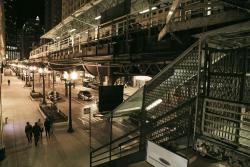 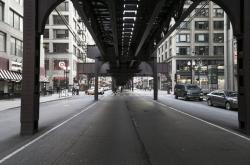   Day 1 – Chicago, Illinois, Palmer House Hilton. Click image to enlarge |
After a restful night at the stunning, historic Palmer House Hotel in Chicago, our entourage of merry motorists briefly paused for a photo op in front of a sign indicating the start of the legendary US highway before setting out in a small armada (see what I did there, Nissan?) of Rogue CUVs and Altima sedans.
While these two vehicles may not be the driving enthusiast’s choice in the Nissan corral (that role is better filled by the 370Z and GT-R), they are nevertheless smart choices for a long cross-country journey like this and represent the type of vehicle many North American families use for their own vacation travel all year round.
All of our test cars were loaded up SL trim models featuring leather, satellite navigation and really decent Bose stereos. Each had a four-cylinder engine attached to a CVT transmission ensuring Nissan’s fuel budget was kept in check. All this combines to make for some excellent long-distance touring machines and pretty great fuel efficiency.
Nissan’s goal for this adventure – in addition to reminding the journalists about the finer points of two of the company’s most important models – was to drive the full length of what’s left of the historic Route 66 highway from Chicago, Illinois to Santa Monica, California. Regretfully for your humble writer, time constraints meant the journey would only be little more than half the full distance, terminating in Albuquerque, New Mexico.
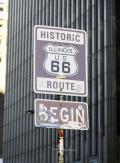 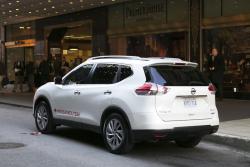 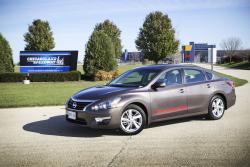 Day 1 – Start of Route 66 in Chicago, Chicagoland Speedway. Click image to enlarge |
Decommissioned in 1985, U.S. Route 66 had been slowly replaced by the faster and more direct Interstate system enabling more efficient motoring between Midwest industry and agriculture and the southwest coast of the United States.
Thanks to this transition to the Interstate system, much of the original route has either been paved over, or in many cases left to return to nature, slowly being swallowed by weeds and grass. Throughout many parts of the length of 66, alternate alignments were created during its nearly 60-year life and many other parts have been given new state-allocated names or numbers.
We sought to follow as much of the historic route as possible – no easy task in many parts – and solicited the help of Gary Fleshmann, a tour guide who has travelled the length of 66 more than 100 times. Thanks to Gary’s experience, hidden gems of the route and a near endless stream of facts about the history of the communities through which the highway travels were always available. Actively participating in our random and often-trivial discussions over the walkie-talkies, Mr Fleshmann made for an entertaining travel companion, and of course never failed to point out the original stretches of Route 66’s 1920s era Portland cement still exposed on several sections.
For many, Route 66 represented the road to a better life particularly for the countless families suffering through the Dust Bowl of the 1930s in the Midwest. By the ’50s, small towns along the Route were thriving thanks to the constant stream of tourists, and an incredible series of kitschy motels, service stations and cafes that linked the miles together.
As the interstates pulled people away from 66 and consequently away from many of those small towns, most of the character-rich landmarks slowly became redundant. Many aspects of the Route 66 story are surprisingly well told in the Pixar film Cars, which modeled many of the buildings in the fictitious “Radiator Springs” after actual buildings along the Route.
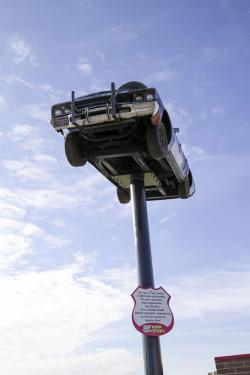 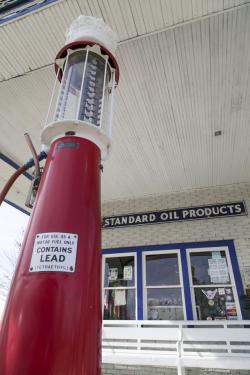 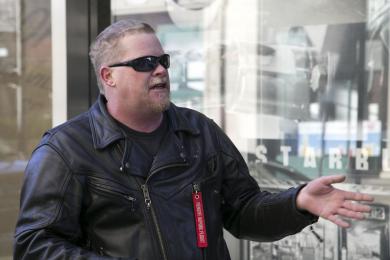 Day 1 – Bluesmobile in Joliet, Illinois; vintage gas pump; Route 66 guide Gary Fleshmann. Click image to enlarge |
Thankfully a number of passionate folks throughout each of the eight states Route 66 traverses have recognized the historic significance of this classic highway and have lovingly restored or preserved some key landmarks. Others – like the numerous classic American motels and service stations in long-forgotten towns – slowly decay into oblivion as a haunting reminder of the cost of progress.
During our first day, the trip took us south from Chicago, through Illinois, passing a handful of icons that still embrace the past. Some, like the restored service centres, celebrate the friendly help motorists could expect along their journey. Other landmarks, like the notorious Stateville Prison, just north of Joliet, IL, or the replica Blues Brothers police car stuck high upon a signpost speak to other, more notorious elements of Americana.
At one point the Chain of Rocks bridge represented an efficient way for Route 66 motorists to get around the traffic of St. Louis, MO, while making the 213 metre span across the mighty Mississippi River crossing from Illinois into Missouri (or Mizzourah as we were told to pronounce it by the locals). But for the last 44 years, it’s been closed to motorized traffic – except with very special permission. Apparently, a motley group of Canadian auto writers in Nissans are special enough to drive across the scenic span.
 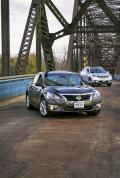 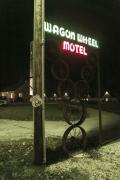 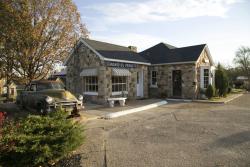 Day 1 – View of Mississippi River; Chain of Rocks Bridge, Illinois-Missouri; Wagon Wheel Motel in Cuba, Missouri. Click image to enlarge |
Our accommodations for the night were in Cuba, Missouri, at the Wagon Wheel Motel. The Wagon Wheel is the oldest still-operating motel along Route 66. Opened in 1935, it has been lovingly restored in recent years to give guests a taste of what it might’ve been like to stay in one of the mom-and-pop-owned motor inns from a bygone era, but now with clean, modern amenities thrown in.
The second day of travel had our team carving through the Ozarks of Missouri, with Hooker’s Cut showcasing a fantastic section of the original Route 66 concrete still in use.
Before heading down into Oklahoma, Route 66 nips the corner of Kansas for all of 11 km. At an old service centre on the outskirts of Galena, we found “Tow Tater”, the decrepit tow truck that inspired “Mater” from Cars. Parked beside is his buddy “Red” the fire truck. The enthusiasm shown for this discovery by everyone in our group reinforces the ageless appeal of the film.
Not far up the road, a quick stop at the Route 66 Welcome Center in Baxter Springs, KS introduced us to Dean “Crazy Legs” Walker – a friendly old fella’ who volunteers as the official ambassador for the Center and just happens to be double-jointed and bow-legged, enabling a freakish party trick.
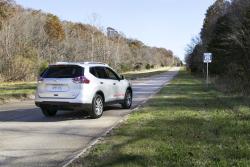 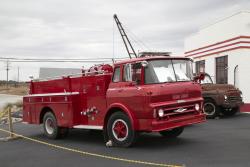 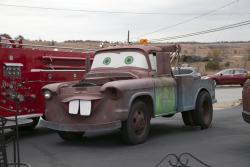 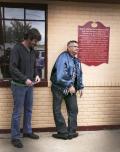 Day 2 – Hooker Cut in Missouri; “Red” and “Mater” in Galena, Kansas; Dean “Crazy Legs” Walter of Baxter Springs, Kansas. Click image to enlarge |
Day two wraps up in Tulsa, Oklahoma at the Campbell Hotel. This place proved to be the best surprise of the trip, with the unassuming exterior giving no indication of the unique and creatively decorated accommodations inside. Situated near the University of Tulsa, this hotel should be on the list of anyone travelling through the area looking for a surprisingly luxurious experience despite the fair cost.
By this point in the trip, my driving companion and I had amassed over six hundred kilometres and several hours in each the Rogue and Altima. We were impressed with each Nissan’s ability to devour long distances with ease and efficiency on either divided highway or secondary routes.
Fuel consumption averages hovered around low 7 L/100 km for the Altima and mid 8’s for the all-wheel-drive Rogue on this trip – not bad at all considering the pace at which my lead-footed co-driver and I were travelling.
More impressive is the comfort of each of these rigs. Nissan’s representatives on the trip were making a pretty big deal about the “NASA-inspired Zero Gravity seats” found in each the Altima and Rogue. While it might sound like a bunch of marketing hype, the reality is that even after several consecutive long days behind the wheel, our group all seemed to agree that the seats were working. Nobody complained of aches and pains, and the stress points on the back, thighs or derriere caused by long hauls in most car seats were non-existent here. Well done, Nissan.
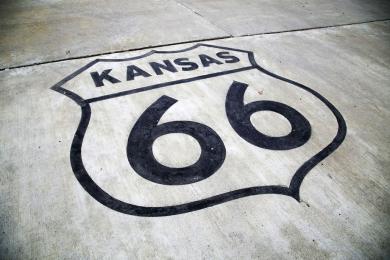 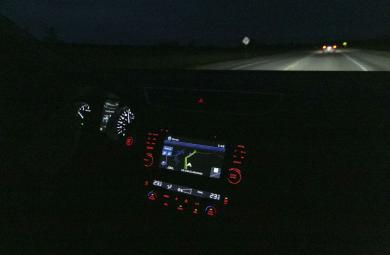 Day 2 – Route marking in Kansas, night driving in Oklahoma. Click image to enlarge |
The success of the Altima and the Rogue on this trip comes more from what the cars didn’t do, rather than what they did do. Out on the open road, both vehicles are quiet and feature infotainment systems that are easy to figure out and offer decent sound quality. At times the zoom in and out touchscreen “buttons” were finicky, but otherwise, the system is fairly quick to respond to commands and offers just enough actual buttons and knobs to keep operation simple.
There’s no question I would have preferred the growl and thrust of Nissan’s powerful V6 to the 2.5L four-cylinder under the hoods of our Altimas for driving fun, but in reality, the smaller engine’s 184 hp never left us needing more power (perhaps just wanting it occasionally). Likewise the 175-hp 2.5L found in the Rogue does an adequate job of propelling its 1,643 kg bulk up to and at highway speeds, even when full of luggage and passengers.
Nissan’s Xtronic CVT is still far from anyone’s favourite transmission, causing a bit of an elastic sensation to acceleration along with a less-than-pleasant mooing sound as the engine revs up and holds the note while accelerating. But, CVTs are known for their efficiency and the Xtronic is no small part of why we were able to achieve such favourable fuel consumption figures throughout the trip, whether highway, city or mixed driving.
On the third travel day, the rain had arrived and the spirits of our entourage seemed to dampen with it. Long, boring stretches of 66 through Oklahoma had my driving partner and I amusing ourselves with juvenile humour, good music offered by our hosts and by using an iPod touch to film farcical “Road Trip Tip” videos such as “How to stave off the incredible need to relieve oneself of too many coffees”.
    Day 3 – Stretch of original Portland cement in Oklahoma; Oklahoma Route 66 Museum; U-Drop Inn in Shamrock, Texas; Amarillo sunset. Click image to enlarge |
Soon the sun broke and we made it into northern Texas in time for a stop at the famous U-Drop Inn of Shamrock before driving on through the most spectacular sunset I’ve ever witnessed, then onward to Amarillo for the night.
Up to this point, our group was required to stay in a fairly tight convoy in order to follow the meandering and often furtive sections of Route 66. But by the fourth day on the road, we were released to travel at our own pace and pick our own stops.
A fun visit to the Cadillac Ranch Art Installation was followed up by some absolutely fantastic home made pie at the MidPoint Café in Adrian, TX. If you find yourself in this part of the state, trust me, you want to stop in and try this treat. Plus the café aptly marks the halfway point of Route 66, making for a good photo op. Not far from the MidPoint is what’s left of the Glenrio ghost town, reminding us of what might have been for all the great landmarks we’ve seen along the way had it not been for the dedication of their current administrators.
    Day 4 – Cadillac Ranch Art Installation, Texas; Jeff making his mark; MidPoint Cafe in Adrian, Texas. Click image to enlarge |
Expectedly, the Rogue rides stiffer than the Altima, but not to the point where it becomes objectionable. Ignoring the cautions of our guide, we pointed the Rogue down an unpaved portion of the original Route 66 alignment that we were warned is often washed out from rain. The little Nissan ute had no trouble making it all the way into San Jon, New Mexico, facing nothing more than some big potholes and washboard gravel. On a few of the slightly rougher spots, the CUV’s added ground clearance and all-wheel-drive peace of mind meant getting shots that would’ve been impossible in the Altima.
The Rogue won more accolades with its luggage compartment too. Although the trunk in Altima is spacious enough to easily swallow a week’s worth of luggage for three people on this trip, it was a Rogue that was selected as the team support vehicle, carrying not only luggage but also a large assortment of Costco-sized snack boxes, cases of water, an espresso maker (!) and other essentials to keep a group of auto journalists from whining more than they usually do. Our test Rogues were not fitted with the optional third row seat, thereby maximizing their cargo carrying capacity.
Ditching the rest of the group, my driving partners and I sought out an authentic local south western dining experience in Tucumcari before stopping at the iconic Blue Swallow Motel. The Blue Swallow is one of the last remaining “No-Tell motels” that featured garages for each room to hide the telltale cars of those having indiscretions within.
As is often the case with a good road trip, it came to an end all too soon, and of course just as things were getting more enjoyable and the scenery more spectacular. Driving through the desert landscape, the expansive vistas never cease to amaze those of us that hail from less dramatic topographies.
    Day 4 – Nissan Rogue loaded with cargo; unpaved stretch of Route 66 in New Mexico, lunch in Tucumcari, New Mexico; Blue Swallow No-Tell Motel. Click image to enlarge |
Albuquerque is a place that deserves more time to explore and shall remain on the bucket list, along with actually completing the rest of the Route 66 journey. Nissan proved their point with the Altima and Rogue on this trip. They’re each pleasantly comfortable and surprisingly efficient, devouring long days on the road with ease, just as well as they’re suited to day-to-day errand runs and commuting.
Still, I can’t help but imagine how much more exciting a trip like this would be in a racy little sports car. With the other half of Route 66 still calling my name, I think I need to start planning my next big road trip. You know, I’d bet Nissan’s 370Z would be a great choice to help me finish checking this journey off my bucket list.
|
Manufacturer’s Website: Nissan Canada Photo Gallery: Crash Test Results: |
Pricing: 2015 Nissan Altima 2.5 SL
Base Price: $29,048
Options: Technology Package, $1,100 (Navigation, Blind Spot Warning, Moving Obstacle Detection, Lane Departure Warning); Metallic Paint, $135.
Destination: $1,695
A/C Tax: $100
Price as Tested: $32,078
Competitors (Altima):
Chevrolet Malibu
Chrysler 200
Ford Fusion
Honda Accord
Hyundai Sonata
Mazda 6
Subaru Legacy
Toyota Camry
Pricing: 2015 Nissan Rogue SL AWD
Base Price: $31,298
Options: Premium Package, $2,800 (LED headlights, Power rear lift gate, BOSE audio system, Navigation, Around View monitor, Blind-Spot warning, Lane-Departure warning, Moving Object Detection, Forward Collision Warning); Metallic Paint, $135.
Destination: $1,750
A/C Tax: $100
Price as Tested: $36,083
Competitors (Rogue):
Chevrolet Equinox
Ford Escape
Honda CR-V
Hyundai Santa Fe
Jeep Cherokee
Kia Sportage
Mazda CX-5
Subaru Forester
Toyota RAV4















